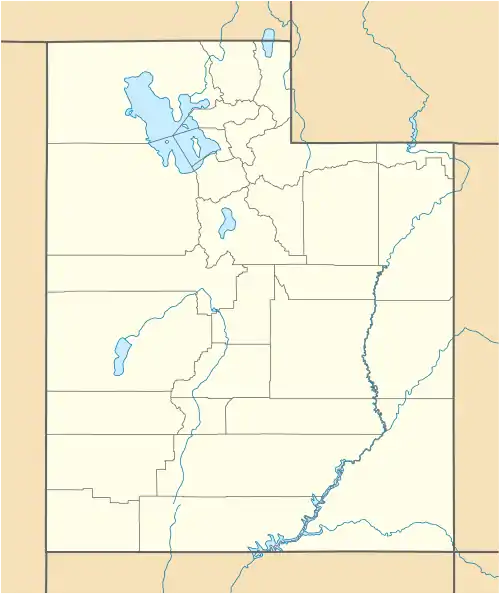| D&RGW 223 | |||||||||||||||||||||||||||||||||||||||||||
|---|---|---|---|---|---|---|---|---|---|---|---|---|---|---|---|---|---|---|---|---|---|---|---|---|---|---|---|---|---|---|---|---|---|---|---|---|---|---|---|---|---|---|---|
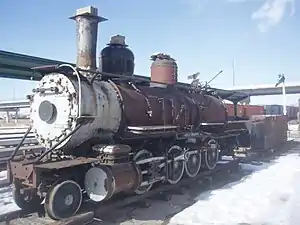 #223 undergoing restoration in 2010 | |||||||||||||||||||||||||||||||||||||||||||
| |||||||||||||||||||||||||||||||||||||||||||
| |||||||||||||||||||||||||||||||||||||||||||
| |||||||||||||||||||||||||||||||||||||||||||
Denver and Rio Grande Western 223 is a 2-8-0 "Consolidation" type narrow-gauge steam railway locomotive built for the Denver and Rio Grande Railroad by the Grant Locomotive Works of Paterson, New Jersey[4] in 1881–82. Number 223 was completed in December 1881, at a cost of $11,553.[5] Baldwin built an additional 25 locomotives in the same class at the same time.[1]
Operational history
Although the Utah State Historical Society suggests that the 223 worked in Utah (the Utah operations of what became the D&RGW were narrow gauge until 1890),[6] and the 223's National Register of Historic Places nomination included this, the Rio Grande Modeling and Historical Society's roster of locomotives does not show it in the Utah section.[2] It was later concluded by Jerry Day that the 223 was never used in Utah.
On December 11, 1892, the Denver & Rio Grande's Salida shops and roundhouse caught fire. The fire started in the waste box in the cab of D&RG No.419 and spread to the oil-soaked floor. Due to the city's fireplugs being shut off because of cold weather, the shop burned to the ground, taking the 223 with it. The 223 was rebuilt soon after and placed back in service.
Only 13 years later, the 223 was involved in another roundhouse fire, this time in Gunnison on January 17, 1905. The 223 again burned along with sister C-16 No. 218. Both locomotives were rebuilt, and the 223's tender tank was replaced in April of the same year.
The Rio Grande Southern Railway was known to lease locomotives from the D&RG. In 1907 the 223 and other C-16s were sent to the RGS, being returned to the D&RG in 1922. On September 12 of that year the 223 collided with C-16 no. 222 in Chama, New Mexico. No records of the damage to either locomotive were kept.[5]
The final location of the 223's operation comes from eight photographs taken by Otto Perry on July 4, 1940, showing 223 working the 18 mile Baldwin Branch,[1] with photographs at Gunnison, Dollard, Castleton, and Baldwin.[2] The Baldwin Branch was originally built by the Denver, South Park & Pacific (Colorado Southern) and retained its original wooden bridges. Due to the weight restrictions of these bridges, the remaining C-16s were the only locomotives permitted on the branch, and the 223 served on this portion of the D&RGW from 1937 to her retirement.[5]
Most of the C-16s were retired by the late 1920s-mid-1930s; only one stayed in service until the mid-1950s (#268 was retired in 1955). The 223 was removed from service in 1941.[7]
On to Utah
The railroad leased 223 to Salt Lake City, beginning at the 1941 Pioneer Day celebration, for five years, and donated it to the city in 1952. The locomotive was given a fake diamond stack and an 1880s paint scheme in the Salida, Colorado, shops, before being sent to Salt Lake City. A popular myth, caused by the mis-captioning of photographs, is that the 223 was moved on a special train led by four brand-new FT locomotives. According to Jerry Day, noted Rio Grande historian, it was actually sister locomotive 268 that was shipped on this special train, not the 223. In 1952, upon the donation to the city, the Rio Grande's Salt Lake City shops removed the diamond stack and box headlight and repainted the 223 in its 1930s "button herald" paint scheme on their own time.
Shipped along with the 223 were a narrow gauge boxcar, caboose, and high-side gondola, which were sent to Pioneer Village in the Lagoon Amusement Park in Farmington, Utah.[5] These cars were later stored in Ogden in poor condition alongside the 223 until they were burned in the 2006 Shupe-Williams Candy Factory Fire.
The 223 sat in the open at Liberty Park, gradually deteriorating from weather and vandalism until 1979, when the city gave it to the Utah State Historical Society. John Bush, employee of the Roaring Camp & Big Trees Railroad in California, was commissioned to make a report on the cost of potential restoration. Lack of budget limited success with the project and it was again transferred, to the Utah State Railroad Museum in 1992.[6] The 223 was stored behind the Shupe-Williams Candy Factory building just to the south of the Union Station, until the candy factory caught fire in 2006 and burned to the ground, taking with it three narrow gauge freight cars. Luckily the cab had already been removed from the engine before the fire. The 223 was then moved from there to its present location at the north end of the Utah State Railroad Museum complex next to the restoration shop. Limited restoration has been underway at its current location, Union Station, Ogden, Utah, with the tender and cab in the Museum's shop and the remainder sitting outside without boiler lagging.[8]
It has been long believed that during the 1979 move from Liberty Park to the Utah State Historical Society property, the frame and rods were bent badly so that the wheels will no longer turn, even with the rods disconnected. However, through analysis of historical photographs, it has been determined that the rods were in actuality bent during its display at Liberty Park to prevent it from rolling. The track on which the 223 was displayed sloped noticeably to the west, with no wheel stops or other end-of-track protection. A flat spot can be felt under the main rod 1 on the Fireman's side of the engine where the jack was placed to bend it.[9] The boiler is in very poor condition, having sat outside for fifty years with wet asbestos around it. The tender is being entirely replaced.[2]
Restoration
Until 2020, restoration work was being done by the Golden Spike Chapter of the Railway & Locomotive Historical Society in the former Trainman's Building at the North end of the Ogden Union Station.
Restoration began in 1992 using a boxcar, UP 910261, as a shop. The group soon outgrew this rudimentary shelter and was given the Trainman's Building after the Candy Factory Fire in 2006. Ogden City paid for roof repairs, an alarm system and fluorescent lighting, and the restoration work was moved inside. At the same time the 223 was moved from its place behind the Shupe-Williams Candy Factory to the north end of the platform outside of the shop.
Currently, the wooden cab is completed, the appliances are repaired, and work on the tender is near complete. The Golden Spike Chapter worked according to the "pay-as-you-go" philosophy, completing work as they obtained the funds, resulting in slow but steady restoration progress.[10]
It was added to the National Register of Historic Places as Grant Steam Locomotive No. 223 in 1979.[3]

In 2019 the R&LHS crew was locked out of the shop by Ogden City and refused to allow continued work on the locomotive at Union Station.[11] In October 2020, restoration of the 223 was halted.[12] The State of Utah has expressed interest in moving the locomotive to a static display in Salt Lake City.[11] Tools and equipment from the R&LHS that were used on the 223 have been donated to the Cumbres and Toltec Scenic Railroad. Stathi Pappas chief mechanical officer of the California Western Railroad and the Stockton Locomotive Works inspected the locomotive in 2021 on behalf of the R&LHS Golden Spike Chapter to determine the feasibility of resuming restoration work.[13]
An ownership issue between Salt Lake City and the State of Utah was resolved in April 2023, legally ensuring ownership of the locomotive was with the Utah State Historical Society.[14] In October 2023, ownership was transferred from the Utah State Historical Society to the City of Ogden.[15] At the time of the transfer, Ogden City officials expressed their hope to resume the locomotive restoration. Steve Jones head of the R&LHS Golden Spike chapter criticized the ownership transfer in a quote published in the Standard-Examiner saying "Ogden City has not been very good at maintaining any of the collection. It's hard to tell what they're going to do with 223."[16]
130th anniversary celebration
2011 marked the 130th anniversary of the 223's construction (1881–2011). In addition, it is the 70th year since the 223's removal from service (1941) and the 20th year since she was moved to Ogden from Salt Lake City. To commemorate the event, the Golden Spike Chapter began uploading to YouTube videos from important events in the 223's recent history, such as the 1991 move from Salt Lake City and the 2006 Candy Factory Fire. The 130th anniversary was also featured in the December 2010, issue of the Colorado Time-Table.
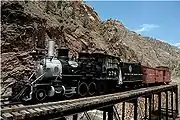 No. 278 is a Baldwin-built sister of #223. In this photo it has been restored to its configuration in about 1940.
No. 278 is a Baldwin-built sister of #223. In this photo it has been restored to its configuration in about 1940. A Grant built sister, #220 in 1920
A Grant built sister, #220 in 1920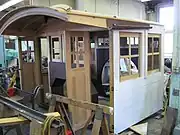 The completely rebuilt cab, constructed using the original methods
The completely rebuilt cab, constructed using the original methods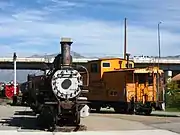 The 223 in 2010
The 223 in 2010.JPG.webp) The boxcar originally used as the restoration shop
The boxcar originally used as the restoration shop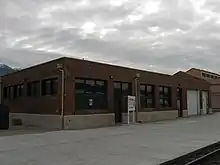 The former Trainmen's Building, the second restoration shop
The former Trainmen's Building, the second restoration shop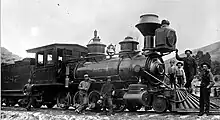 D&RG 287 (a sister engine to D&RG 223) in 1885. This shows how the D&RG 223 looked originally, with a diamond stack, box headlight, trim on the domes, and wooden pilot (cowcatcher). Photo courtesy of the Colorado RR Museum, Golden, CO.
D&RG 287 (a sister engine to D&RG 223) in 1885. This shows how the D&RG 223 looked originally, with a diamond stack, box headlight, trim on the domes, and wooden pilot (cowcatcher). Photo courtesy of the Colorado RR Museum, Golden, CO. D&RG "Standard Consolidation Engine," 1881 (showing what D&RG 223 originally looked like). A "consolidation" is a 2-8-0 wheel arrangement.
D&RG "Standard Consolidation Engine," 1881 (showing what D&RG 223 originally looked like). A "consolidation" is a 2-8-0 wheel arrangement.
See also
References
- 1 2 3 Official Roster No. 11 of the Denver and Rio Grande Western Railroad System. Denver: The Denver and Rio Grande Western Railroad System. April 1, 1923.
- 1 2 3 4 "Denver & Rio Grande Locomotive History: 223". Rio Grande Modeling and Historical Society. Retrieved 28 January 2010.
- 1 2 "National Register Information System". National Register of Historic Places. National Park Service. March 13, 2009.
- ↑ "New Jersey's Locomotive Builders". New Jersey Railroad Information. Retrieved 2 February 2010.
- 1 2 3 4 Jerry Day. History of D&RGW Locomotive Number 223.
- 1 2 "The Locomotive 223 Photograph Collection, 1978-1993". Utah State Historical Society. Archived from the original on January 11, 2010. Retrieved 28 January 2010.
- ↑ Jones, Larry; Harris, Lois (1978). "National Register of Historic Places Nomination: Grant Steam Locomotive No. 223" (PDF). National Park Service.
{{cite journal}}: Cite journal requires|journal=(help)"Accompanying 6 photos, from 1979" (PDF). National Register of Historic Places Inventory. - ↑ "D&RGW Steam Locomotive #223". Ogden Union Station. Archived from the original on 4 January 2010. Retrieved 28 January 2010.
- ↑ "Stephen Smith". Narrow Gauge Discussion Forum. Retrieved 14 January 2011.
- ↑ "D&RGW 223 restoration project". Golden Spike Chapter, Railway & Locomotive Historical Society. Retrieved 2 April 2010.
- 1 2 Shenefelt, Mark (December 20, 2019). "Historic train restoration stalls at Ogden's Union Station". Standard Examiner. Associated Press. Retrieved September 23, 2022.
- ↑ "Cumbres & Toltec and the Golden Spike Chapter". 11 August 2020.
- ↑ "223 Inspection for possible restoration work". gsrlhs.com. R&LHS Golden Spike Chapter. November 5, 2021. Retrieved October 28, 2023.
- ↑ "Utah State Historical Society receives full ownership and control over D&RGW #223," Rail Preservation Network website, https://railpreservation.network/2023/04/14/utah-state-historical-society-receives-full-ownership-and-control-over-drgw-223/. Retrieved August 31, 2023.
- ↑ Weist, Ellen (October 26, 2023). "Utah Historical Society approves ownership transfer of Locomotive 223 to Ogden". agilitypr.com. Utah State Historical Society. Retrieved October 28, 2023.
- ↑ Vandenack, Tim (October 28, 2023). "On track to Restoration". Ogden, Utah. Retrieved October 28, 2023.
